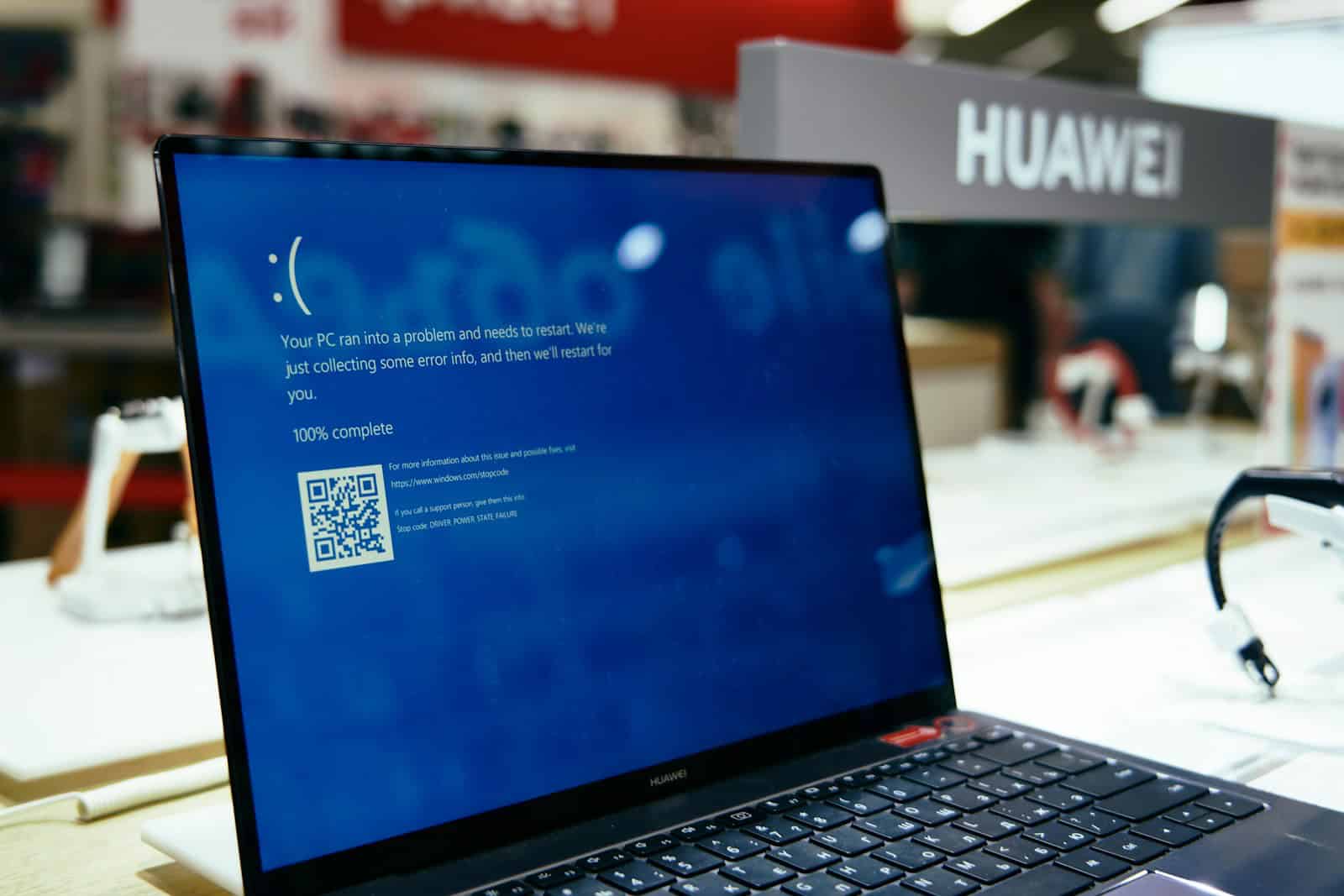Microsoft is making a big change to one of its most recognizable features – the Blue Screen of Death (BSOD). This error screen appears when Windows crashes badly. It has been a familiar sight for Windows users for many years.
Microsoft is redesigning the classic Blue Screen of Death, breaking with a long tradition in Windows operating systems. The company has quietly revealed this change, which will affect how system crash notifications appear. While the BSOD has long been associated with major system failures, its new look marks a significant update to this iconic (if unwelcome) Windows feature.
Many Windows users have encountered the blue error screen at some point. Whether you’re working on an important document or playing a game, seeing this screen means trouble. Microsoft provides several troubleshooting steps for these errors, including starting in safe mode, checking Device Manager, and making sure your hard drive has enough space.
A New Look for a Notorious Screen
The Blue Screen of Death (BSOD) has haunted Windows users for decades. It’s instantly recognizable—a jarring blue screen with white text that shows up when your system crashes. But now, Microsoft is giving this infamous error screen a serious makeover. The new design, already appearing in preview builds of Windows 11, replaces the traditional blue background with black, signaling a shift in both tone and visual identity.
Why Change the Color?
The decision to move away from blue isn’t just about aesthetics. Microsoft is rethinking how it communicates critical system errors to users. The old BSOD design, with its stark contrast and technical jargon, often felt intimidating. By switching to black, Microsoft is aligning the error screen with Windows 11’s sleeker, more modern UI, and reducing the psychological shock that comes with system failure. It’s a small but deliberate change meant to soften the experience, especially for casual users who may not understand what’s happening when their computer crashes.
The black background also fits better with the broader theme of Windows 11’s visual overhaul. With more emphasis on rounded corners, dark mode elements, and a minimalist design language, the new BSOD blends into the operating system more naturally, instead of screaming at you in panic.
The Emoticon and QR Code Are Gone
Another notable shift in this new design is the removal of the sad face emoticon and the QR code. These elements were introduced in Windows 8 and Windows 10, partly to humanize the crash experience and partly to help users look up the error using their phone. Now, they’re gone—likely because they weren’t serving their purpose effectively. The QR code was rarely used, and the sad face, while cute, didn’t actually help users resolve anything.
Instead, Microsoft has opted for a simpler, text-based message that gets straight to the point: “Your device ran into a problem and needs to restart.” It still includes a stop code for troubleshooting, but it looks cleaner and more professional overall.
Green Screens for Insider Builds
If you’re part of the Windows Insider program, you may have noticed that error screens during testing phases have a green background instead of black. This isn’t a new idea—it’s something Microsoft has done in previous Insider builds to differentiate between production and development versions of the OS. Green screens make it easier for Microsoft to identify where bug reports are coming from and avoid confusion with public releases.
Is This the End of the “BSOD”?
Technically, it’s still a Blue Screen of Death—even if it’s not blue anymore. The term “BSOD” is so deeply rooted in tech culture that it’s likely to stick around regardless of what color Microsoft uses. But this redesign is more than a visual update; it reflects a philosophical shift in how Microsoft wants people to interact with their operating system.
Crashes happen. Instead of shocking users with a bright blue warning, Microsoft is aiming for a calmer, less jarring experience that still provides the necessary information for support and diagnostics.
What This Means for the Future of Windows
The BSOD redesign may seem like a minor detail in the grand scheme of things, but it hints at bigger changes coming to how Windows handles system stability and user communication. Microsoft has been pushing toward more proactive error handling with features like automatic diagnostics, cloud-based troubleshooting tools, and better error reporting in the background.
In the future, crashes might not even need a screen at all. They could be logged, reported, and silently resolved through system updates or AI-assisted diagnostics. But until that future arrives, Microsoft is making sure that even when things go wrong, they go wrong with a little more grace.
The Blue Screen of Death isn’t going away—it’s evolving. And in doing so, it’s becoming just a little less scary, a little more polished, and a lot more in step with the design-forward direction of Windows 11.
Key Takeaways
- Microsoft is redesigning the traditional Blue Screen of Death for Windows, changing its appearance after many years.
- The BSOD appears when Windows experiences a severe crash that prevents normal operation.
- Users can troubleshoot blue screen errors by using safe mode, checking hardware, and ensuring sufficient disk space.
Evolution of Microsoft’s Blue Screen
Microsoft’s error screen has undergone several important changes since its introduction. The iconic blue background that once defined Windows system crashes is now shifting to black, while maintaining its essential function of alerting users to serious system problems.
From Blue to Black: The Shift in Error Screens
The Blue Screen of Death (BSOD) has been a staple of Windows for decades. When a system crash occurs, this screen appears with technical information about the error. According to recent reports, Microsoft is now replacing the traditional blue background with black, creating what some are calling the Black Screen of Death.
This redesign removes familiar elements like the frowning face emoticon and QR code that were added in previous versions. The new black screen offers a simpler, sleeker look while maintaining its core purpose of providing error information.
The change represents Microsoft’s effort to modernize the Windows user experience. The company likely hopes the new design will be less jarring for users while still communicating the seriousness of system failures.
Windows Insider Preview Changes
The redesigned error screen first appeared in Windows Insider Preview builds. Microsoft often tests major interface changes with this group before rolling them out to all users.
Windows Insider participants received early access to the new Black Screen of Death in recent preview builds of Windows 11 24H2. This approach lets Microsoft gather feedback on the redesign before finalizing it for general release.
Key changes in the preview version include:
- Replacement of blue background with black
- Removal of the frowning face emoticon
- Elimination of the QR code that previously linked to support resources
These changes represent a significant shift in how Microsoft approaches error messaging. The company appears to be moving toward a more minimalist design philosophy across Windows.
Comparing the Blue Screen and Green Screen of Death
Microsoft has actually used different colored error screens for different Windows versions and user groups:
| Screen Color | Usage |
|---|---|
| Blue | Standard error screen for most Windows users |
| Black | New replacement design being introduced |
| Green | Used exclusively in Windows Insider preview builds |
The Green Screen of Death was introduced specifically for Windows Insider users to help Microsoft identify which error reports came from preview builds versus standard releases.
Each version contains similar technical information about the system crash. The color difference serves as a visual indicator of which Windows version encountered the problem. This helps Microsoft’s development team quickly sort through error reports and prioritize fixes.
The evolution from blue to green to black shows how Microsoft continues to refine even the least enjoyable parts of the Windows experience.
Troubleshooting and Resolving BSOD Issues
When faced with the dreaded Blue Screen of Death, having a systematic approach to fixing the problem can save time and prevent data loss. The right troubleshooting steps often depend on identifying specific error codes and using built-in Windows recovery tools.
Deciphering the Stop Error Codes
Stop error codes provide valuable clues about what caused your system to crash. These alphanumeric codes (like 0x0000007B or KERNEL_DATA_INPAGE_ERROR) point to specific problems. Windows generates these codes to help identify issues with hardware, drivers, or system files.
When you see a BSOD, write down the complete error code that appears on screen. You can then search for this code on Microsoft’s support site or reliable tech forums.
Common error codes include:
- 0x0000000A: Usually indicates incompatible drivers or hardware issues
- 0x0000001E: Often related to faulty RAM
- 0x000000C5: Typically associated with driver problems
Modern Windows versions store crash information in the Event Viewer. Access it by typing “Event Viewer” in the search bar and checking the System logs for more details.
Safe Mode and System Restore Options
Safe Mode boots Windows with minimal drivers and services, making it useful for troubleshooting. To enter Safe Mode in Windows 10/11, restart your PC and press F8 during startup, or use Settings > Update & Security > Recovery.
In Safe Mode, you can:
- Uninstall recently added software
- Update or roll back problematic drivers
- Run system diagnostic tools
System Restore lets you return your computer to an earlier working state. To use it:
- Type “System Restore” in the search bar
- Select a restore point from before the BSODs started
- Follow the prompts to complete the process
If your PC won’t boot normally, access these tools through the Windows Recovery Environment by pressing F11 during startup or using a recovery drive.
Preventive Measures: Updates and Malware Protection
Regular maintenance helps prevent future BSODs. Windows Update provides critical fixes for system vulnerabilities and compatibility issues. Check for updates by going to Settings > Update & Security > Windows Update.
Driver updates are equally important. Outdated or incompatible drivers are common BSOD triggers. Use Device Manager to identify problematic drivers marked with warning symbols.
Malware can corrupt system files and cause crashes. Install reputable antivirus software and run regular scans. Windows Defender provides built-in protection, but consider supplementing it with specialized anti-malware tools.
Hardware monitoring software can alert you to potential issues before they cause BSODs. Watch for unusual CPU temperatures or RAM errors that might indicate failing components.
Back up important data regularly. Even with perfect prevention, hardware can fail unexpectedly. External drives or cloud storage provide safety nets against data loss during system crashes.
Frequently Asked Questions
Blue screen errors can be frustrating and confusing for Windows users. These errors often appear unexpectedly and may have different causes and solutions depending on your specific situation.
What causes the Blue Screen of Death (BSOD) in Windows operating systems?
The Blue Screen of Death typically occurs when Windows encounters a critical system error it cannot recover from safely. Common causes include faulty hardware, damaged drivers, memory problems, or software conflicts.
Hardware failures like bad RAM, overheating components, or failing hard drives frequently trigger BSODs. Outdated or corrupted device drivers can also cause these errors when they conflict with system operations.
Sometimes Windows updates or newly installed software may introduce incompatibilities that lead to system crashes and blue screens.
How can one troubleshoot the Blue Screen of Death on Windows 10 or 11?
Start by restarting your computer in safe mode to determine if the problem persists in a minimal environment. This helps identify if a recently installed program is causing the issue.
Check Device Manager for any hardware with warning icons and update drivers as needed. Microsoft Support suggests removing any new hardware to see if that resolves the problem.
Ensure you have sufficient free disk space and run Windows Update to install the latest patches and fixes. Memory diagnostic tools can help identify RAM problems that often cause blue screens.
What are the new changes to the Blue Screen of Death in the latest Windows update?
Microsoft is redesigning the traditional Blue Screen of Death with a simpler, sleeker interface. According to search results, the error screen might change color from the traditional blue to another color.
The new error screen maintains essential information but presents it more clearly. It displays the specific error or faulty driver and simply states “your device ran into a problem and needs to restart.”
These changes aim to make the error information more accessible and less intimidating for average users while still providing necessary details for troubleshooting.
Are there any official fixes from Microsoft for the Blue Screen of Death?
Microsoft provides built-in troubleshooting tools to help users resolve blue screen errors. The Windows Memory Diagnostic tool can identify memory-related issues that commonly cause BSODs.
The company regularly releases updates and patches to fix system stability issues. Using Windows Update ensures your system has the latest fixes for known problems.
For persistent issues, Microsoft Support offers detailed troubleshooting guides on their support website. These include step-by-step instructions for resolving common blue screen scenarios.
What steps should be taken immediately after encountering a BSOD to prevent data loss?
Record the error code and stop code displayed on the blue screen. This information is crucial for diagnosing the specific problem.
After restarting, check for any unsaved work in recovered files. Many programs have auto-recovery features that can restore documents after a crash.
Avoid making major system changes until you understand the cause. Running a reliable backup program after restarting can protect important data in case the issue recurs.
Can frequent BSODs indicate a hardware issue, and how should it be addressed?
Yes, recurring blue screens often point to hardware problems. Components like RAM, hard drives, and power supplies are common culprits when BSODs happen regularly.
Start by checking your computer’s temperature, as overheating frequently causes stability issues. Cleaning dust from internal components and ensuring proper ventilation can resolve heat-related crashes.
Testing components individually can identify the problem part. Run memory diagnostics for RAM issues, check disk health with diagnostic tools, and consider replacing components that repeatedly cause errors.







